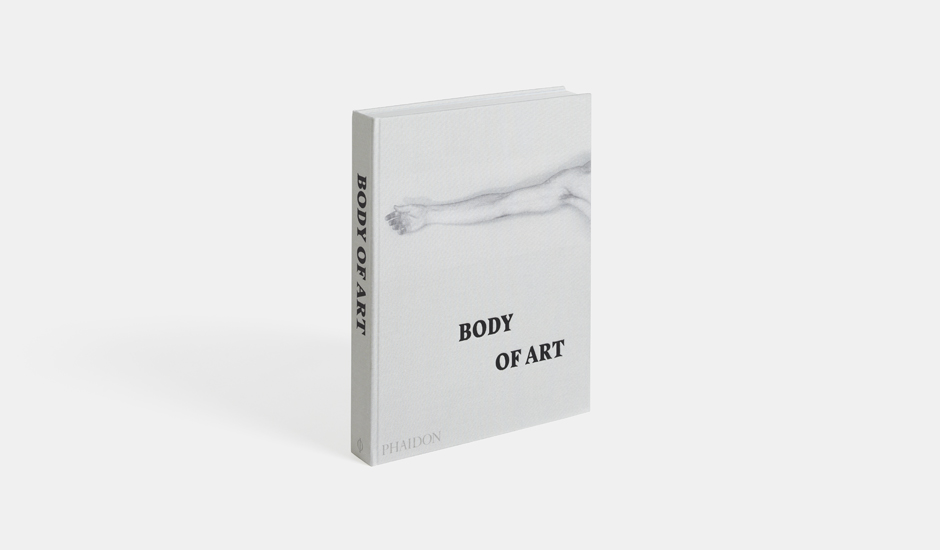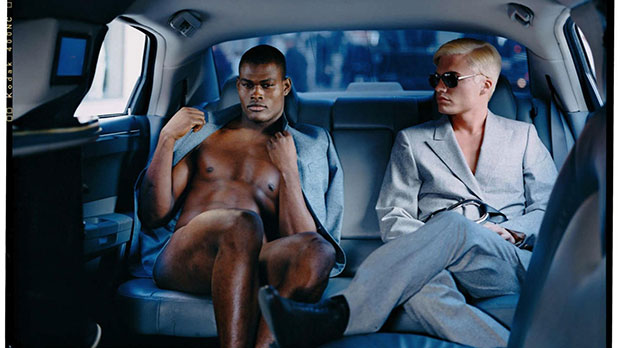
My Body of Art - Tina Barney on her nudes, why she admires Rineke Dijkstra and that Halston photo
The photographer talks about the human body in her photographs and more in our latest Body of Art interview
New York photographer Tina Barney is known the world over for her striking portraits of her well to do family and friends, pictured at home and at play in New York and in New England. These large scale colourful photoraphic works are, she has said, the result of hours of painstaking picture making and taking. Indeed, it can take a hundred or more shots for the person Barney envisages in her mind to emerge in the photograph. More recently she collaborated - albeit remotely - with Stephen Shore to produce some of images in the great Phaidon book, The Noguchi Museum A Portrait. You can read more about that here.
A lesser known part of Barney's back catalougue however, is the series of nude portraits she created in the early 1990s. Exhibited just once and since left to gather dust in a closet in her Rhode Island home, in these rarely seen photographs Barney reacted against what she says had become for her the somewhat stilted poses of her friends and family. She used them to explore a new avenue of artistic endeavour - one which while it may have had the naked human body at its core was fundamentally not about sex, nudity, or even, she says, the body itself. Confused? Hopefully you won't be after reading on.
"I had been connected to the New York City School for Painting and Sculpture for some time, because deep down I would love to draw and paint! But I’d always been interested in nudes so I asked the school if I could photograph some of their models. All I knew at the time is that I didn't want them to be in 'a typical nude model environment', I wanted the photos to be more personal. So, after hiring them, I asked if I could shoot them where they lived. I shot them on 8 X 10 and when I got the contacts back I immediately realised why most artists try at some point to work with the nude - it’s because of the skin, and the colours of the skin!
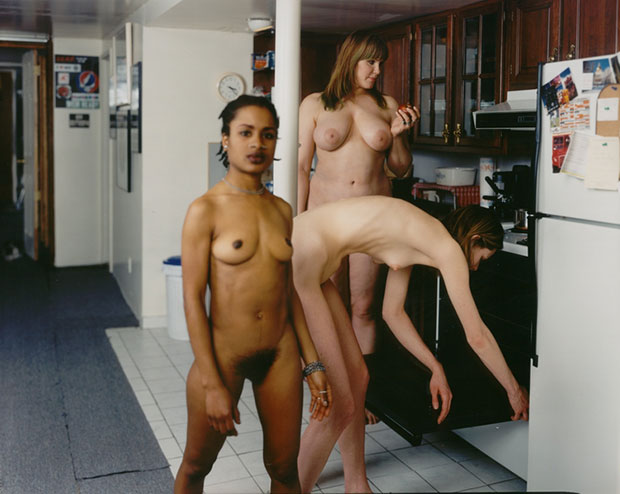
"My photographic work often gets labelled as the upper class at home - and, it's true, interior is very important to me - but deep down, the human figure is perhaps what I am really in love with - it's certainly a primary interest. That said, I don’t know if it has anything to do with the fact that it’s a human being. Basically, to me, photographing the body is the same as photographing apples and oranges in a still life. I actually think it has to do with the form.
“So with the nude photographs, I don’t think I was interested at all in making a narrative. I wasn’t interested at all in trying to understand any kind of emotion or the meaning of a facial expression. The body was really what it was about - but kind of in an anonymous way. The photographs were never about those specific human beings."
Barney says at this point she had become "tired" of photographing family and friends. "They weren’t actors and they’d get stiff and they couldn’t remove themselves, and then I got these people that were willing to get into the role and that was very exciting for me.
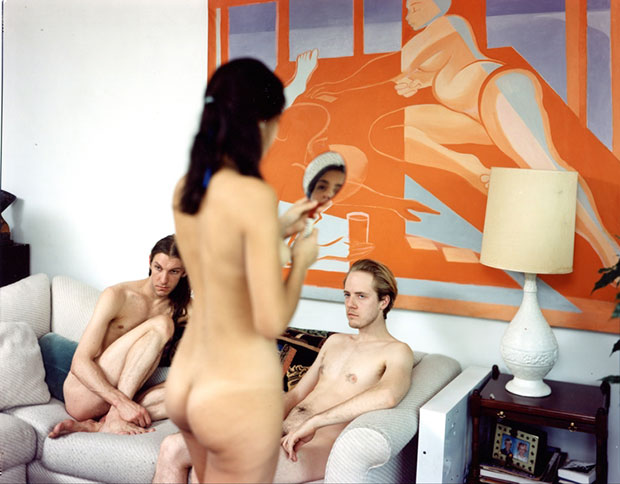
“First of all there was this clinical kind of understanding, an automatic unconscious understanding that this should be really clinical. It was as if I were a surgeon and I’d gone into the operating room. There was a separation between the fact that this is a human being and that they were naked. I did not want the photos to ever be about sex. It really was about formality, composition, structure, texture, light, and form.
"What I think is interesting is that if you take a room and then you put a human being into it, dressed or not dressed, and you could introduce a doll or a crate or anything else what’s the difference between the human being and those other things that aren’t alive? It’s hard to separate in my mind the difference between a human being and the fact that they are alive. I think, for me, a huge part of it is the skin. Because in all the pictures I’ve done in my own work, the hands are crucial. And I think the skin is what sort of attracts my eye when I'm under the dark cloth.”
One of the particularly interesting chapters in Body of Art is the one dealing with identity. Artists of all periods, but particularly from the early 20th century onwards, have often sought to disrupt the assumptions we make about identity from reading physical attributes and have presented images of individuals whose identities are not what they first appear. Portraits memorialize a singular indentity, freezing time and human attributes and creating images that nevertheless change with the perception of the individual viewer. Identity is multifaceted and mutable, but at times one aspect of it captures particular attention and becomes the overriding definition of an individual. Motherhood as one such aspect can be seen in art across the centuries, in representations ranging from religious depictions of the Virgin Mary to Mary Cassatt's intimate portraits of mother and child. But the emotionally charged photographic potraits of women holding new borns by Rineke Dijkstra dramatically contrast with the typically idealized and sanitized portrayal of motherhood.
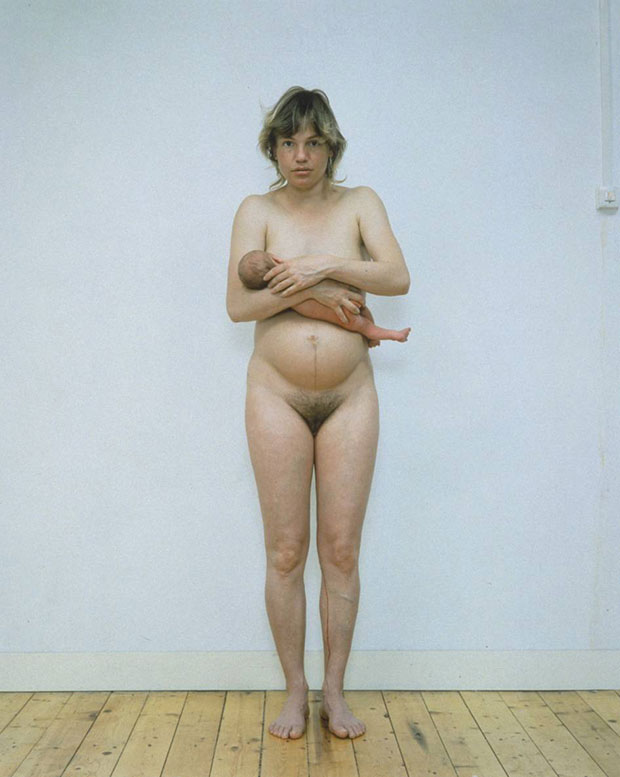
There are a number of artists in Body of Art whose work Barney admires but she saves her strongest praise for Dijkstra, represented in Body of Art by her 1994 photograph, Tecla. Dijkstra photographed her subjects standing naked in front of a blank wall in naturalistic and stark lighting. The setting emphasises details that might otherwise go unnoticed, disclosing the toll of pregnancy for instance on a woman’s body. The large scale format combined with the subject staring straight into the camera lens intensifies the impression that these mothers are not simple passive archetypes to be consumed by the viewer, but specific individuals.
“I love all these sociological questions Rineke Dijkstra portrays and she digs down into them in a way that’s really interesting. She is very important to me in what she gets out of a human being because I know how hard that is to do. And I have to say her videos are the things that I just swoon over. Because also sociologically, they are really interesting to me. Because deep down that’s another love of mine. I had a similar thing going on with my Europeans project: ‘What’s going on here? Why do these people do these things?’

We had to finish by asking Tina what she remembered of the famous Arena Homme + shoot, The Limo, recreating what would have been for fashion designer Halston a typical night out in the Seventies. The photograph, shot in the back of a stretch limousine, combines some of the most important elements of Barney's practice: the carefully wrought expertise she brings to the depiction of skin, space, light place, composition and relationships - into a simple yet powerful image. It's one of the greatest fashion photos of our age, so it's somewhat surprising to hear her being rather self-deprecating about it.
"The idea was to take this model, dye his hair and dress him up like Halston and take him back to his haunts and locations in New York City. I can’t remember if that model was famous and it was to change his look - that might have been part of it. They were two human figures and they were in a stretch limo, so technically and physically it was a feat in itself to get in there with a four X five view camera and my assistant was in the front seat shining light through the chauffeur’s tiny peep hole. It was a miracle that the picture came out though! And once again, these are two kinds of actors, it’s almost like a phenomena that I had very little control over; I was just trying to get something on film."
To gain greater understanding of the Body in Art and plenty more besides, buy a copy of Body of Art here. To get some more examples of Tina Barney's work check out her book with Stephen Shore The Noguchi Museum A Portrait. And don't forget Shore's Survivors in Ukraine.
